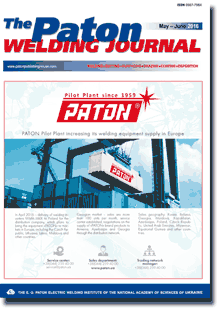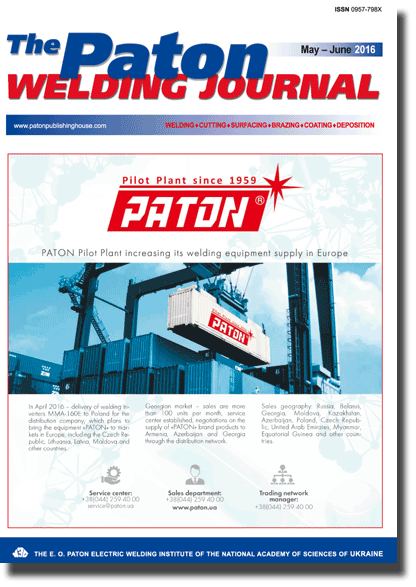| 2016 №06 (20) |
DOI of Article 10.15407/tpwj2016.06.21 |
2016 №06 (22) |

The Paton Welding Journal, 2016, #5-6, 124-129 pages
Using the theory of growing bodies in calculation of stress-strain state of the parts manufactured applying additive cladding technologies
I.K. Senchenkov1, I.A. Ryabtsev2, E. Turyk3 and O.P. Chervinko1
1S.P. Timoshenko Institute of Mechanics, NASU, 3 Nesterov str., 03057, Kiev, Ukraine. E-mail: ang@imech.freenet.kiev.ua
2E.O. Paton Electric Welding Institute, NASU, 11 Kazimir Malevich Str., 03680, Kiev, Ukraine. E-mail: office@paton.kiev.ua
3Institute of Welding, 16-18 Bl. Czeslaw Str., 44-100, Gliwice, Poland. E-mail: eugeniusz.turyk@gliwice.pl
Abstract
Proceeding from the theory of growing bodies and unified model of flow, a model was developed for assessment of thermomechanical state of the part in multilayer cladding, as well as finite-element procedure of numerical realization of the model. In the case of cladding (building-up) a cylinder along its side surface it was established that the schematic of one-time building-up allows rather quickly obtaining qualitative evaluations of the level of stresses and strains at analysis of different variants of technological solutions for multilayer cladding of parts. However, it does not allow for the significant inhomogeneity and celullar structure of distributions, but just describes the smooth averaged change of characteristics of stresses and strains along the cylinder. It does not even allow studying such fine technological points as influence of different schematics of deposited bead overlapping on stress-strain state of the part. In this case, it is recommended to use the procedure of calculation by the schematic of bead-by-bead building-up (deposition). Generally satisfactory agreement of calculated and experimental data is indicative of the validity and reliability of the developed approach to modeling the thermomechanical processes in multilayer cladding of parts. 14 Ref., 9 Figures.
Keywords: cladding, additive technologies, theory of growing bodies, stress-strain state, residual stresses, deposited beads, deposited layers
Received: 05.04.16
Published: 19.07.16
References
- Balyakin, A.V., Smelov, V.G., Chempinsky, L.A. (2012) Application of additive technologies for development of combustion chamber parts. Vestnik SamaraGAKU, 34(3), 47–51.
- Marya, S., Hascoet, J.Y., Panigrah, S.K. et al. Additive manufacturing, derivative of welding and joining technology: A literature review. IIW Doc. XII-2185–14; IV-1195–14.
- Smurov, I.Yu., Konov, S.G., Kotoban, D.V. (2015) About implementation of additive technologies and production in national industry. Novosti Materialovedeniya. Nauka i Tekhnika, 14(2), 11–20.
- Kovalev, O.B. (2015) Fundamental problems of modeling and diagnostics of processes in laser technologies of additive production of 3D metal pieces. In: of 11th All-Union Congress on Fundamental Problems of Theoretical and Applied Mechanics (Kazan, Russia, 20–24 Aug. 2015), 1836–1838.
- Makhnenko, V.I., Kravtsov, T.G. (1976) Thermal processes in mechanized surfacing of parts of circular cylinder type. Kiev: Naukova Dumka.
- Makhnenko, V.I., Velikoivanenko, E.A., Kravtsov, T.G. et al. (2001) Numerical studies of thermomechanical processes in surfacing of shafts of ship mechanisms. The Paton Welding J., 1, 2–10.
- Arutyunyan, N.Kh., Drozdov, A.D., Naumov, V.E. (1987) Mechanics of growing of viscous-elastic-plastic bodies. Moscow: Nauka.
- (2006) Technology of welding, brazing and cutting: Encyclopedia, Vol. III-4. Ed. by B.E. Paton. Moscow: Mashinostroenie.
- Bodner, S.R. (2000) Unified plasticity — an engineering approach: Final report. Haifa: Israel IT.
- Ryabtsev, I.A., Senchenkov, I.K. (2013) Theory and practice of surfacing operations. Kiev: Ekotekhnologiya.
- Ryabtsev, I.A., Senchenkov, I.K., Turyk, E. (2015) Surfacing, materials, technologies, mathematical modeling. Gliwice: Silesia PI.
- Senchenkov, I.K., Ryabtsev, I.A., Turyk, E. et al. (2005) Calculation of residual stresses in multilayer helical cladding of cylindrical parts on the base of theory of growing of viscous-plastic bodies. Proizvodstvo, 9, 18–25.
- ASTM Standard E 837: Standard test method for determining residual stresses by the hole drilling strain-gage method.
- (1993) Measurement of residual stresses by the hole drilling strain gage method. Group Inc. Tech. Note.
Suggested Citation
I.K. Senchenkov, I.A. Ryabtsev, E. Turyk and O.P. Chervinko (2016) Using the theory of growing bodies in calculation of stress-strain state of the parts manufactured applying additive cladding technologies. The Paton Welding J., 06, 124-129.The cost of subscription/purchase order journals or individual articles
| Journal/Currency | Annual Set | 1 issue printed |
1 issue |
one article |
| TPWJ/USD | 384 $ | 32 $ | 26 $ | 13 $ |
| TPWJ/EUR | 348 € | 29 € | 24 € | 12 € |
| TPWJ/UAH | 7200 UAH | 600 UAH | 600 UAH | 280 UAH |
| AS/UAH | 1800 UAH | 300 UAH | 300 UAH | 150 UAH |
| AS/USD | 192 $ | 32 $ | 26 $ | 13 $ |
| AS/EUR | 180 € | 30 € | 25 € | 12 € |
| SEM/UAH | 1200 UAH | 300 UAH | 300 UAH | 150 UAH |
| SEM/USD | 128 $ | 32 $ | 26 $ | 13 $ |
| SEM/EUR | 120 € | 30 € | 25 € | 12 € |
| TDNK/UAH | 1200 UAH | 300 UAH | 300 UAH | 150 UAH |
| TDNK/USD | 128 $ | 32 $ | 26 $ | 13 $ |
| TDNK/EUR | 120 € | 30 € | 25 € | 15 € |
AS = «Automatic Welding» - 6 issues per year;
TPWJ = «PATON WELDING JOURNAL» - 12 issues per year;
SEM = «Electrometallurgy Today» - 4 issues per year;
TDNK = «Technical Diagnostics and Non-Destructive Testing» - 4 issues per year.


